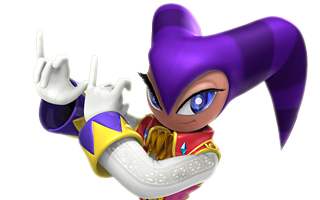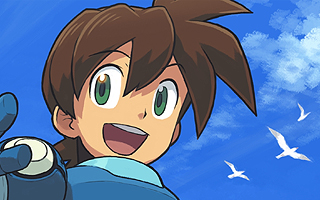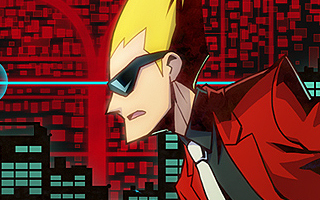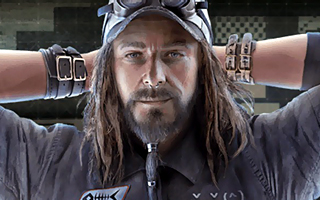7th Generation Gems
Top 10 Overlooked Games from the 7th Generation of Video Games!
The 7th generation of video game consoles provided perfect conditions for hidden gems to form. The Wii was able to attract legions of new gamers, but many of its most innovative titles were buried under an avalanche of shovelware. At the same time, the increased development costs associated with HD graphics made it difficult for publishers to take real risk. Many AAA blockbusters were boring and uninspired as a result, but they overshadowed creative titles from smaller studios simply because they had more marketing muscle behind them. Whether they were underrated by critics or overlooked by consumers, the games listed here failed to garner the attention they deserved. For the purpose of this list, the games are being ranked in order of how underrated they are. As usual, I’m also disregarding licensed games or titles that were successful enough to spawn sequels.
10
Lost in Shadow
Lost in Shadow (2010)

It’s fair to say that the Wii wasn’t exactly a graphical powerhouse, but Lost in Shadow works well with the limitations of the system by using a simple art style that’s almost entirely based around the concept of light and shadow. The gameplay is also married to this concept, and it’s rare to see a game where the art and play mechanics are so perfectly integrated. The premise of the game revolves around the detached shadow of a young boy that’s attempting to work its way up to the top of a unreasonably tall tower. Although the shadow can only move in two dimensions, its necessary to interact with three dimensional objects. By pulling various switches, players can manipulate objects in the foreground in an effort to change the shadows that are projected onto the tower’s wall. With a strong emphasis on platforming and puzzle-solving, Lost in Shadow feels a lot like cinematic platformers from the 16-bit era. The game doesn’t quite live up to its potential and doesn’t do as much with its concept as it could have, but it’s still a unique experience that deserved more attention that it got.
9
Vanquish
Multiplatform (2010)

PlatinumGames was one of the greatest developers of their day, and Vanquish was one of their most ambitious efforts. Vanquish is a third-person action game that could be described as a faster (and more over-the-top) version of Gears of War. Concepts like the slide-boost allow the game to move along at an accelerated pace and provide players with a way to contend with the relentless enemies. Players are bombarded with curtains of bullets, and the game almost feels like a classic 2D shoot ’em up at times. While other games in the genre are largely built around their cover systems, Vanquish encourages players to keep moving. Missiles come in from all directions and the environments are highly destructible, and this allows the gameplay to evolve beyond the “hide behind a wall and slowly chip away at your opponent’s health” dynamic that similar games employ. Vanquish is a relatively short game, but it’s a fun ride while it lasts. The action is blisteringly-fast from beginning to end, and there’s never a dull moment.
8
Mark of the Ninja
Multiplatform (2012)

On the topic of great stealth games, most gamers will immediately think of Metal Gear or Splinter Cell, but Mark of the Ninja deserves to be mentioned as one of the best. The game is centered around 2D platforming and challenges players to avoid guards and perform silent assassinations. The game relies heavily on a “line of sight” mechanic, but sound also plays a big role. The simple act of running can give away your location. There are a lot of ways to dispatch enemies, but efficiency is paramount since there’s always the risk of alerting nearby guards. Guards can sound the alarm if they spot a player or find a body, so a wide variety of tactics are often needed in order to succeed. You can even try to instill fear in your opponents by throwing dead bodies at them! Mark of the Ninja received universal praise when it was released and it’s widely considered one of the best Xbox Live Arcade games. I’m willing to go a step further. Mark of the Ninja is not only one of the best Xbox Live Arcade games, it’s one of the best games on the Xbox 360, period.
7
Pandora’s Tower
Nintendo Wii (2011)

In 2011, a fan campaign known as Operation Rainfall was formed to convince Nintendo to localize three Wii games that were not slated for an American release. The community eventually got their way, and the games found their way to western audiences. All three of the games were underappreciated in their own right, but Pandora’s Tower is the best fit for this list. Xenoblade Chronicles was successful enough to warrant a sequel on the Wii U and The Last Story was the best selling game ever released by Xseed Games, but Pandora’s Tower didn’t get the same level of critical reception or media attention. An action/RPG that combines elements of Zelda, Rygar, and Castlevania, Pandora’s Tower is filled with interesting gameplay mechanics. Players are armed with a magical sword, but most useful weapon is a lengthy chain that can be used in a number of creative ways. You can disarm your opponents, target specific body parts, or chain multiple enemies up together. You can also latch onto your enemies and swing them around with reckless abandon. Naturally, the chain can also snag items from a distance or hook onto grapple points. The game is based around dungeon exploration and inventive boss battles, but the heart of the game is its melancholy storyline involving the protagonist and his cursed lover. Players are basically racing against the clock to prevent the girl from turning into a monster, and this provides ample encouragement for them to find shortcuts and complete tasks in a timely fashion.
6
Deadly Creatures
Nintendo Wii (2009)

A lot of the Wii’s success can mostly be attributed to family-friendly games, so it’s easy to understand why a game like Deadly Creatures was ignored by the masses. The game gives players the choice of playing as a venomous scorpion or a deadly tarantula and pits them against a myriad of insects, reptiles, and other critters. The carnage feels like a small-scale version of a classic monster movie, and this is especially apparent in the boss battles. It’s relatively easy to contend with beetles and crickets, but players will also encounter a Gila Monsters, a rattlesnake, and even a human! Battles are the most important element of the game, but exploration also plays a role. The imaginative levels will require you to burrow under ground, crawl on walls, and use the Wii remote to shoot spider webs. The most surprising aspect of the game is how dynamic the story is. Two human characters (voiced by Dennis Hopper and Billy Bob Thornton) drive the game forward as you watch on from the perspective of a predatory arachnid. Deadly Creatures had a unique concept that would have stood out on any console, but it felt especially novel on the Wii.
5
The Saboteur
Multiplatform (2009)

A stylish open-world sandbox game set in Nazi-occupied France during the second World War, The Saboteur follows the exploits of an drunken Irish racecar driver who is recruited by the Resistance. Like most games in the genre, The Saboteur presents players with a variety of missions that put heavy emphasis on driving and shooting, but the more interesting sections require players to stick to the shadows, steal enemy uniforms, and blend in to their surroundings. The game is a little rough around the edges, but it earns points for its atmosphere and unique art style. The game adopts a striking black-and-white motif in the Nazi-occupied areas of France, and the color returns as parts of the city are liberated. The streets of Paris makes for an interesting backdrop and helps the game stand out from the usual suspects. Whether you’re planting explosives in enemy strongholds or taking in a sexy burlesque show, The Saboteur is full of excitement. I would have loved to see the concept expanded upon, but The Saboteur was the last hurrah for Pandemic Studios.
4
Enslaved: Odyssey to the West
Multiplatform (2010)

Enslaved: Odyssey to the West is centered around a brawny wildman named Monkey, a resourceful genius named Trip, and a filthy pervert named Pigsy. Fans of Dragon Ball might draw comparisons to Goku, Bulma, and Oolong respectively, but that’s mostly because Enslaved and Dragon Ball were both re-imaginings of the classical novel, Journey to the West. The game is set in a post-apocalyptic world in which the remnants of humanity are plagued by robots left over from a global war. Players assume the role of Monkey, and a strong emphasis is placed on platforming. Fans of Prince of Persia or Assassin’s Creed will likely appreciate the game’s parkour aspects. Monkey finds himself in a position where he has to protect Trip, and the entire game can be described as an elaborate escort mission. Trip isn’t completely useless, however, and she carries her weight by hacking security doors, scanning for land mines, and distracting enemies. The relationship between Monkey and Trip is surprisingly touching, and it’s a lot of fun to see the characters evolve as the story progresses. Although the game was well-received by critics, its sales were not substantial enough to warrant a sequel.
3
Lost Odyssey
Microsoft Xbox 360 (2007)

The Xbox 360 was never able to get a foothold in Japan, but it wasn’t for a lack of trying. The Last Odyssey is a JRPG from Mistwalker that was intended to appeal directly to Japanese gamers. The game was designed by Hironobu Sakaguchi (the father of Final Fantasy), it featured music by the legendary Nobuo Uematsu, and it relied heavily on traditional RPG concepts. The turn-based battles and random encounters hearken back to early Final Fantasy games, and the way players traverse the world map is also familiar. As is the case with many RPGs, the best thing about Lost Odyssey is its story. The game focuses on an immortal being name Kaim who loses a thousand years of memories. As he struggles to overcome his amnesia, his memories return to him in dreams that are presented to players in a style similar to visual novels. These segments advance the plot and add a lot of emotional weight to the characters. The Last Odyssey was generally well-received, but many critics complained about the lengthy loading times. It was later revealed that review copies had longer load times than the retail version, but most critics made no effort to amend their reviews. A lot of people maligned the game for being too traditional, but it’s a perfect fit for anyone looking for an old-school RPG with fascinating characters and an emotionally-gripping storyline.
2
Majin and the Forsaken Kingdom
Multiplatform (2010)

Majin and the Forsaken Kingdom wasn’t even on my radar until I played it. The game wasn’t especially well-received by critics and was largely overlooked by the gaming press in general, but I think it could have developed a strong cult following if it had a little more fanfare. The game looks and feels like something Studio Ico would release, and comparisons to The Last Guardian arose immediately after the game was revealed. (Ironically, the game ended up being released six years before The Last Guardian was.) The structure of the game is mostly based around a massive Majin that players have to cooperate with. Although they have no direct control over the mystical beast, players can give the Majin commands to aide in combat or puzzle-solving. The Majin gains new abilities as the game progresses, and this allows for new battle strategies and more complicated puzzles. If “Ico meets Where the Wild Things Are” sounds compelling to you, then Majin and the Forsaken Kingdom might be right up your alley. An imaginative game with memorable environments and charming characters, Majin and the Forsaken Kingdom deserved more love.
1
Rodea the Sky Soldier
Nintendo Wii (2015)

Three versions of Rodea the Sky Soldier were released in 2015, but this entry specifically recognizes the Wii version. In many cases, it’s beneficial for a game to be released on multiple platforms. In the case of Rodea, the Wii U and 3DS ports lost the plot completely and destroyed the legacy of the original version. The game was initially designed by Prope (Yuji Naka’s indie studio) for the Wii. The game revolves around a flying robot named Rodea who soars through the sky to defend his kingdom from an ancient empire. Early builds drew comparisons to Naka’s previous games (like NiGHTS into Dreams… and the Sonic the Hedgehog series), but publisher Kadokawa Games decided to shelve the project in favor of outsourced 3DS and Wii U ports. The Wii version was in limbo for several years after it was completed, but it was eventually released in 2015… as a free bonus alongside the Wii U version. The original version used the Wii remote for aiming, but the Wii U version was ported from the 3DS and used thumbsticks instead. As if the new control scheme wasn’t bad enough, the Wii U port also featured washed out graphics and introduced a fuel system that needlessly placed limits on Rodea’s flying time. Critics panned the Wii U and 3DS ports upon their release, but the Wii version was basically ignored. Prope’s original Wii version of Rodea is a vibrant game with intuitive controls. It’s unfortunate that it had to die for the sins of the Wii U port.





Do you agree with this list? Let us know what you think by leaving a comment below. Your opinion matters!